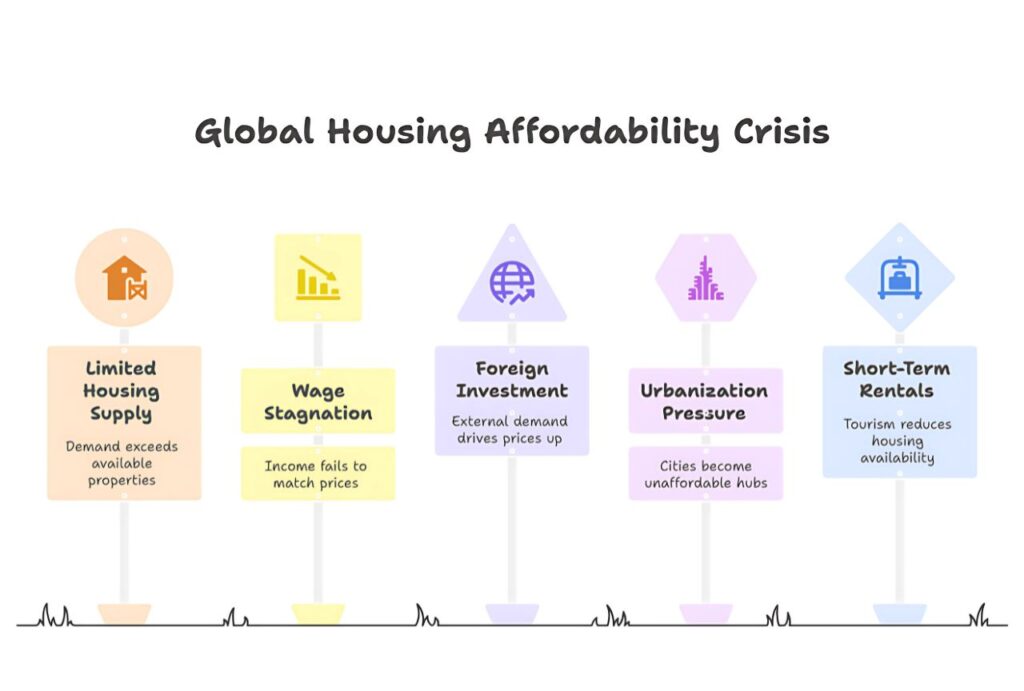Housing affordability has become one of the most debated issues in developed countries. While many headlines focus on rising property prices, the real question is how incomes compare to those costs. A home that seems expensive in one country may actually be easier to buy due to higher salaries, while a cheaper property elsewhere can be out of reach when wages lag behind. This is why the price-to-income ratio is the most reliable measure for understanding true affordability.
In this article, we rank developed countries with high living standards by housing affordability using the latest price-to-income ratios. The comparison highlights where homeownership is hardest to achieve and where it remains within reach, offering a clear picture that goes beyond surface-level housing prices. By reviewing these numbers, you’ll see how different economies balance property values with income levels, and why affordability challenges vary so widely across nations.
How Housing Affordability Was Measured
To provide a clear and comparable view of housing affordability across developed countries, this ranking relies on the price-to-income ratio, one of the most widely recognized indicators used by economists and housing analysts. The ratio reflects how many years of average annual income are needed to purchase a typical home in each country. A higher ratio indicates that homes are less affordable relative to income levels, while a lower ratio suggests better accessibility to homeownership.
The data used for this comparison is based on aggregated figures from public housing market and cost-of-living databases that gather information from local real estate listings, user-submitted data, and official national statistics. These sources are continuously updated to capture market changes and ensure consistency across countries.
By focusing on the relationship between median home prices and average disposable household income, this approach gives a more accurate representation of affordability than looking at property prices alone. It reflects how local wage conditions and living standards influence the real ability of individuals and families to purchase homes in each market.

Housing Affordability Ranking in Developed Countries in 2025
31. South Korea – Price-to-Income Ratio: 23.4
South Korea ranks as the least affordable housing market among developed countries. The gap between salaries and property prices is especially visible in Seoul, where demand far outweighs supply. Rapid urbanization and limited land availability have pushed property values to levels far above average income growth. Younger generations face some of the greatest barriers to homeownership, often requiring family financial support or turning to long-term renting. Despite the government’s attempts to cool the housing market through regulations and tax reforms, affordability remains one of the most pressing concerns for South Koreans.
30. Singapore – Price-to-Income Ratio: 22.4
Singapore also ranks among the world’s least affordable markets when measured by price-to-income ratio. However, its situation is distinct from South Korea. While private housing prices are extremely high, the country’s strong public housing system, managed by the Housing and Development Board (HDB), provides access to subsidized homes for the majority of citizens. This dual-market structure means that while affordability challenges are very real in the private sector, locals benefit from policies that prioritize long-term ownership through public housing schemes. Even so, the high ratio reflects how costly property remains for those seeking homes outside government-subsidized options or for permanent residents and expatriates.
29. Portugal – Price-to-Income Ratio: 14.6
Portugal’s housing affordability crisis has intensified over the past decade. While property prices in cities such as Lisbon and Porto have surged, wages have not kept pace, leading to one of the highest ratios in Europe. A major driver has been foreign investment and short-term rental demand from the tourism industry, which pushed housing costs beyond the reach of many local families. This imbalance has led to growing pressure on the rental sector and rising concerns about the long-term sustainability of homeownership. Efforts by the Portuguese government to regulate short-term rentals and increase affordable housing supply reflect the urgency of the issue for residents.
28. Czech Republic – Price-to-Income Ratio: 13.6
The Czech Republic ranks among the least affordable housing markets in Europe, with Prague at the center of the problem. Housing demand in the capital has far outpaced supply, pushing prices up rapidly in recent years. While the country has seen consistent economic growth, wages have not risen quickly enough to offset these increases, leaving many households priced out of ownership. Younger residents are particularly affected, with a significant portion relying on rentals or extended family housing. Government initiatives aimed at improving affordability have been slow to ease the pressure, keeping the price-to-income ratio among the highest in the region.
27. Greece – Price-to-Income Ratio: 13.1
Housing affordability in Greece continues to be a challenge despite recent signs of economic recovery. Property prices have risen steadily in major urban centers such as Athens and Thessaloniki, while incomes remain comparatively low after years of financial crisis and austerity. Foreign demand, especially from investors seeking residency permits through property purchases, has added pressure to the market. For many Greek households, renting has become the default option, with homeownership becoming increasingly difficult to achieve for younger generations. Government initiatives to expand social housing and regulate short-term rentals aim to ease affordability pressures, but progress has been limited.

Also Read: Ranking of Work-Life Balance in Developed Countries in 2025
26. Austria – Price-to-Income Ratio: 11.8
Austria faces an affordability challenge, particularly in Vienna, where demand for housing continues to grow. The country has a long tradition of social and cooperative housing, which has helped reduce pressure for many residents, but private market prices remain high relative to income levels. The strong appeal of Austrian cities to both locals and international buyers has further intensified housing costs. While mortgage access is relatively stable, rising interest rates have made it harder for families to transition from renting to owning. The result is a growing gap between those with access to long-term subsidized housing and those relying solely on the private market.
25. Japan – Price-to-Income Ratio: 11.3
Japan’s affordability challenge is shaped by its unique demographic and economic context. In major cities like Tokyo and Osaka, property prices are high compared to household incomes, keeping the national ratio elevated. At the same time, rural regions face the opposite issue—declining populations and large numbers of vacant homes, which remain difficult to sell despite being more affordable. Wage stagnation has further limited the ability of younger households to purchase property in urban areas. While Japan benefits from low mortgage interest rates, the urban-rural divide and demographic shifts mean that accessibility to housing remains uneven across the country.
24. Estonia – Price-to-Income Ratio: 11.1
Estonia’s housing market has seen significant growth in prices, particularly in Tallinn, where demand from both domestic and foreign buyers has surged. Rapid economic development and integration into the European Union have supported rising living standards, but income growth has not kept pace with property costs. Younger households and first-time buyers feel the greatest impact, often needing to take on longer mortgages to secure homes in urban areas. Although Estonia maintains a relatively small housing market compared to larger European economies, the pace of price increases has created concerns about long-term affordability and financial stability for local families.
23. Lithuania – Price-to-Income Ratio: 11.1
Lithuania’s housing affordability challenges are concentrated in major cities such as Vilnius and Kaunas, where property prices have risen faster than wages in recent years. Economic growth and increased demand from both domestic buyers and international investors have fueled rapid price increases. Younger households often find themselves stretched by long mortgage commitments, with affordability concerns most visible among first-time buyers. Government incentives for housing loans have helped some families, but the widening gap between urban and rural markets shows that homeownership remains much easier outside major cities.
22. Poland – Price-to-Income Ratio: 10.9
Poland has experienced one of the fastest-growing housing markets in Central Europe. Rising wages have improved living standards, but the increase in property prices, especially in Warsaw, Kraków, and Wrocław, has outpaced income growth. Foreign investment, limited housing supply, and strong demand from a growing middle class have contributed to the affordability gap. Many Polish families now face the choice of taking on larger mortgages or extending rental periods before purchasing a home. While government programs aimed at supporting first-time buyers have provided some relief, the overall affordability issue remains a key concern, especially for younger generations entering the housing market.
21. Malta – Price-to-Income Ratio: 10.8
Malta’s housing market has been shaped by strong foreign demand, limited land availability, and population growth in a small geographic area. Property values have risen quickly over the last decade, while wages have grown at a slower pace, leaving affordability under pressure. The rise of short-term rental properties catering to tourism has further reduced availability for local residents, increasing competition in both the rental and ownership markets. For many Maltese households, accessing homeownership has become significantly more difficult compared to previous generations, and affordability concerns are now among the top socio-economic challenges in the country.

20. Switzerland – Price-to-Income Ratio: 10.7
Switzerland’s high housing costs reflect a combination of strong demand, limited space in urban regions, and an attractive market for international investors. Cities like Zurich, Geneva, and Basel are among the most expensive in Europe, making affordability a significant issue for local residents despite high national incomes. Unlike many other countries, Switzerland has a relatively low homeownership rate, with a large portion of the population renting long term. While high wages offer some balance, the elevated price-to-income ratio shows that buying a home remains out of reach for many households, particularly younger professionals and families living in urban centers.
19. France – Price-to-Income Ratio: 9.9
Housing affordability in France is heavily shaped by regional disparities. Paris and its surrounding areas dominate the market with prices that far exceed average incomes, making homeownership particularly difficult for younger households and middle-class families. In contrast, smaller cities and rural areas offer more manageable prices, though job opportunities are often more limited outside urban centers. Government measures, such as rent controls and subsidized housing programs, have attempted to improve access, but the price-to-income ratio shows that many French households continue to struggle in high-demand regions where incomes lag behind property costs.
18. Luxembourg – Price-to-Income Ratio: 9.6
Luxembourg combines one of the highest living standards in the world with some of the steepest housing costs in Europe. The country’s strong economy attracts a large international workforce, fueling demand in a market with limited land availability. This demand has driven housing prices upward much faster than wage growth, resulting in affordability challenges even among households with above-average incomes. For locals, the high price-to-income ratio reflects a growing concern that property ownership is increasingly out of reach without substantial financial support or long-term mortgage commitments.
17. Canada – Price-to-Income Ratio: 9.4
Canada’s housing affordability crisis is most visible in metropolitan areas such as Toronto and Vancouver, where property values are among the highest in the world relative to incomes. While national incomes are relatively strong, they have not risen quickly enough to keep pace with escalating real estate prices. Foreign investment, limited supply in urban centers, and high population growth from immigration have intensified the issue. Many younger Canadians are postponing homeownership, turning to longer rental periods or relying on intergenerational wealth to enter the market. The national ratio highlights the strain on households, particularly in provinces with rapidly growing urban centers.
16. Italy – Price-to-Income Ratio: 9.0
Italy presents a mixed picture in terms of housing affordability. Property values are significantly lower in southern regions and smaller towns, but incomes in these areas are also lower, keeping the affordability ratio high. In major cities such as Milan and Rome, rising prices combined with stagnant wage growth have created barriers for first-time buyers. Italy’s aging population and limited wage progression among younger workers further add to the challenge. Although some opportunities exist in less populated areas, for many Italian households the gap between income and property costs remains a significant obstacle to ownership.
15. United Kingdom – Price-to-Income Ratio: 8.7
The United Kingdom continues to face long-standing affordability issues, particularly in London and the southeast of England, where property prices are far beyond the reach of average incomes. Regional variations are significant, with northern cities and parts of Scotland offering more affordable options, yet wages in these regions are typically lower. High demand, limited housing supply, and a history of rapidly rising property values have placed consistent pressure on affordability. The ratio illustrates how homeownership remains a challenge for younger generations, with many households forced to rent longer before being able to consider buying.

Also Read: Is Everyone Successful Except You? Here’s How To Stop Feeling Like a Loser
14. Spain – Price-to-Income Ratio: 8.6
Spain’s housing market reflects sharp regional differences. In cities like Madrid and Barcelona, affordability is a pressing issue as prices have grown much faster than wages. The popularity of short-term rentals and second homes, often driven by international demand, has intensified pressure on locals seeking permanent housing. At the same time, smaller towns and rural areas remain far more accessible, but income levels there are typically lower, balancing the ratio at a national level. For many Spanish households, especially younger workers, the combination of stagnant salaries and urban housing costs continues to limit access to homeownership.
13. Latvia – Price-to-Income Ratio: 8.6
Latvia’s affordability challenges are concentrated in Riga, where most economic activity and population growth are centered. While housing prices remain lower than in many Western European countries, the ratio highlights that local incomes are not high enough to offset the costs of purchasing property in urban areas. Many Latvians still rely on family support or long mortgage terms to secure ownership. Outside the capital, affordability improves, but employment opportunities are more limited, keeping demand centered on cities and sustaining pressure on the market.
12. Germany – Price-to-Income Ratio: 8.5
Germany has one of the strongest economies in Europe, but its housing affordability issues have grown steadily in recent years. Major cities such as Berlin, Munich, and Frankfurt have seen significant price increases driven by high demand, urbanization, and limited housing supply. Wages in Germany are generally strong, yet they have not risen quickly enough to match the pace of housing inflation. A notable feature of the German market is its historically high proportion of long-term renters, which continues today as many households are priced out of ownership. Government housing initiatives and rent control measures are attempts to manage affordability, though challenges remain acute in large urban centers.
11. Norway – Price-to-Income Ratio: 8.5
Norway combines high living standards and strong wages with one of the more expensive housing markets in the Nordic region. Oslo and other urban areas have experienced rapid property price growth, while rural areas remain more affordable. Despite relatively high incomes, the price-to-income ratio indicates that homeownership is still a significant financial commitment for many households. Access to credit and stable mortgage structures have helped, but affordability pressures are increasingly evident for younger Norwegians entering the housing market. The challenge is particularly visible in urban regions where supply struggles to keep pace with demand.
10. Australia – Price-to-Income Ratio: 8.4
Australia’s housing affordability issue is among the most widely discussed in developed countries. Sydney and Melbourne stand out as some of the least affordable cities globally, with prices far exceeding income growth. While the national ratio reflects severe affordability concerns, regional cities and towns provide more accessible options, though they often lack the same job opportunities. Strong immigration, population growth, and limited housing supply in urban centers have pushed prices higher, while wage increases have lagged behind. For many Australians, especially first-time buyers, purchasing property in major cities requires longer mortgage terms and greater financial sacrifice compared to previous generations.
9. Sweden – Price-to-Income Ratio: 8.2
Sweden faces persistent housing affordability issues, particularly in Stockholm, Gothenburg, and Malmö. Strong population growth and limited new construction in high-demand areas have kept prices elevated compared to incomes. Sweden’s mortgage market, which allows for long repayment terms and interest-only options, has helped some households enter ownership but has also added long-term financial commitments. Rental housing is heavily regulated, with waiting lists in major cities stretching for years, leaving many households dependent on the costly private market. While wages are relatively strong, the national ratio reflects the difficulty of balancing income with property costs in urban regions.

8. Finland – Price-to-Income Ratio: 7.8
Finland’s housing affordability varies significantly between Helsinki and the rest of the country. The capital region faces high demand and rising property prices, while smaller towns and rural areas often experience stagnant or even declining housing markets. Wage growth has been steady, but it has not matched the pace of property increases in Helsinki, where younger households face the steepest challenges. The Finnish government has supported housing construction and offers subsidies for first-time buyers, yet affordability in the capital remains strained, keeping the overall price-to-income ratio elevated.
7. Iceland – Price-to-Income Ratio: 7.7
Iceland’s housing market has been under pressure due to limited housing supply and rapid population growth over the past decade. Reykjavik, where most of the population is concentrated, has seen sharp price increases compared to incomes. Tourism-driven demand and foreign investment have also added to market pressures. Despite relatively high wages, many households struggle to keep pace with the cost of ownership, particularly younger buyers. Government efforts to encourage new construction have helped ease some pressure, but affordability remains a challenge in urban areas while opportunities outside Reykjavik remain limited.
6. New Zealand – Price-to-Income Ratio: 7.6
New Zealand has long faced housing affordability concerns, with Auckland being one of the least affordable cities in the developed world. Property prices have risen dramatically over the past two decades, outpacing income growth and creating barriers for first-time buyers. While smaller cities and rural towns offer more affordable options, employment opportunities are concentrated in major urban areas, keeping demand high where prices are least affordable. Government housing initiatives and restrictions on foreign buyers have been introduced, but affordability challenges remain a significant issue across the country, reflected in the high national price-to-income ratio.
5. Netherlands – Price-to-Income Ratio: 7.4
The Netherlands has one of the most competitive housing markets in Europe. Cities such as Amsterdam, Utrecht, and Rotterdam have experienced strong demand, limited housing supply, and rising property values that outpace wage growth. Many Dutch households rely on long-term mortgages, often stretching to maximum borrowing capacity, to enter the housing market. High rental costs and limited availability of social housing add further pressure. Despite high living standards and stable incomes, the price-to-income ratio indicates that affordability is a growing concern, particularly for younger buyers seeking to enter the urban housing market.
4. Ireland – Price-to-Income Ratio: 6.8
Ireland’s housing market has been shaped by limited supply and consistent demand, especially in Dublin and other major cities. Rapid economic growth and population increases have put pressure on property availability, raising prices faster than wages. While incomes in Ireland are among the higher levels in Europe, the shortage of affordable new housing continues to challenge first-time buyers. Government initiatives, including shared equity schemes and grants for new builds, aim to reduce barriers, yet supply constraints remain the primary issue keeping affordability tight. The ratio reflects a market where strong wages help, but housing costs remain a central concern for many households.
3. Belgium – Price-to-Income Ratio: 6.6
Belgium’s housing affordability appears stronger than in many neighboring countries, partly due to moderate price growth compared to steady wage increases. Cities like Brussels and Antwerp face higher affordability challenges, but regional areas remain relatively accessible. Belgium also benefits from a strong tradition of homeownership, with many families passing down property, reducing pressure for younger generations. Government tax benefits for homeowners and a stable mortgage system have contributed to keeping affordability more manageable. The overall ratio highlights Belgium as one of the more balanced markets in Europe, though regional inequalities still play a role.
2. Denmark – Price-to-Income Ratio: 6.1
Denmark stands out in Europe for its relatively favorable affordability levels. While Copenhagen continues to experience high housing demand and strong price growth, other cities such as Aarhus and Odense remain far more accessible compared to income levels. Danish households often benefit from flexible mortgage structures, including long-term fixed rates, which improve affordability despite rising prices in urban areas. High wages, strong labor protections, and effective housing policies contribute to Denmark’s lower ratio, making it one of the more sustainable housing markets in Europe from an income perspective.
1. United States – Price-to-Income Ratio: 3.4
The United States shows the lowest ratio among the countries ranked, indicating relatively stronger affordability compared to incomes on a national scale. However, the figure masks sharp differences between regions. Metropolitan areas like San Francisco, New York, and Los Angeles face severe affordability challenges, while much of the Midwest and South remain accessible for first-time buyers. A wide availability of mortgage products, competitive lending rates, and varied housing markets across states contribute to the national average. While high-cost cities struggle with affordability, the overall low ratio reflects the vast number of regions where homeownership is still achievable relative to income.
Housing affordability continues to shape the economic stability and quality of life across developed nations. The price-to-income ratio highlights not only the balance between wages and housing costs but also the structural strengths and weaknesses of each country’s housing policies, labor markets, and regional dynamics. For governments, these figures act as a clear indicator of where intervention is needed most—whether in boosting housing supply, improving mortgage accessibility, or ensuring wages keep pace with rising living costs.
For individuals, understanding these ratios provides clarity when weighing decisions about buying, renting, or relocating. It shows that affordability is not just about house prices in isolation but how incomes align with them in practice. As global economic conditions shift, affordability will remain one of the defining challenges for both policymakers and households, shaping opportunities and mobility across the developed world.



